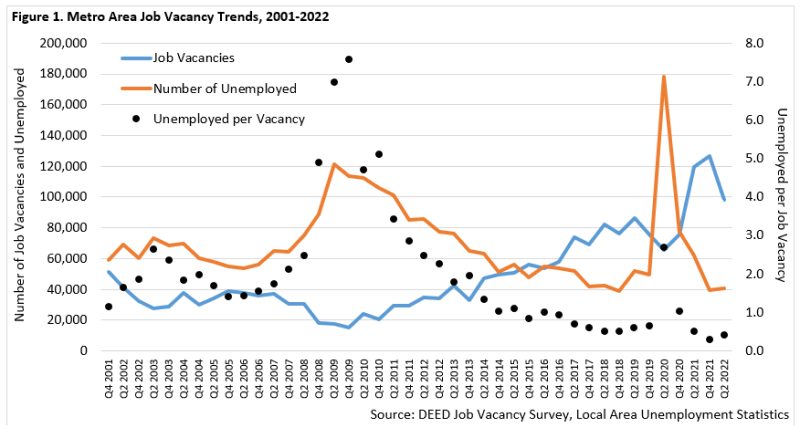 The Minneapolis-St. Paul metropolitan area is a national leader in finance, advanced manufacturing, agriculture and retailing.
The Minneapolis-St. Paul metropolitan area is a national leader in finance, advanced manufacturing, agriculture and retailing.
Medical devices, electronics and processed foods are strong suits recognized globally.
Want the freshest data delivered by email? Subscribe to our regional newsletters.
4/24/2023 9:00:00 AM
Tim O'Neill
According to newly released data from DEED's Job Vacancy Survey (JVS), employers in the Twin Cities Metro Area had 98,330 job vacancies in 2022. This represents the third highest number of job vacancies in the region since the JVS data was first collected in 2001, only behind the record number of vacancies reported in the second and fourth quarters of 2021 (Figure 1).

Combining JVS data with unemployment data from DEED's Local Area Unemployment Statistics (LAUS) program reveals how tight the Metro Area's labor market is. While unemployment spiked during the COVID-19 recession in 2020, it has since dropped to historic lows. Together, DEED's JVS and LAUS data showed there were 0.3 unemployed persons per job vacancy in 2021. With the number of job vacancies dropping in 2022, along with slightly higher unemployment, these data showed there were 0.4 unemployed persons per job vacancy in 2022. So, while the Metro Area's labor market is showing signs of loosening, it is still very much a tight labor market.
So how do these 98,330 job vacancies break down? By industry sector, Health Care & Social Assistance had the most job vacancies, and by a wide margin. With over 25,400 job vacancies in 2022, Health Care & Social Assistance accounted for over one-quarter (25.9%) of the Metro Area's total job vacancies. This was nearly twice as many job vacancies as the industries reporting the second and third most during that period: Retail Trade with over 12,900 job vacancies and Accommodation & Food Services with nearly 12,800 job vacancies. Rounding out the top five industries were Manufacturing, with nearly 9,100 job vacancies, and Professional & Technical Services, with over 6,600 job vacancies (Table 1).
| Table 1. Metro Area Job Vacancies by Industry, 2022 | |||||
|---|---|---|---|---|---|
| Industry | Number of Vacancies | Share of Total Vacancies | Job Vacancy Rate | Median Wage Offer | Requires Postsecondary Education |
| Total, All Industries | 98,330 | 100.0% | 6.0 | $19.96 | 38% |
| Health Care & Social Assistance | 25,433 | 25.9% | 9.2 | $21.06 | 54% |
| Retail Trade | 12,944 | 13.2% | 8.4 | $16.03 | 7% |
| Accommodation & Food Services | 12,771 | 13.0% | 11.6 | $16.34 | 1% |
| Manufacturing | 9,077 | 9.2% | 5.4 | $24.61 | 30% |
| Professional & Technical Services | 6,640 | 6.8% | 5.5 | $31.50 | 74% |
| Educational Services | 5,713 | 5.8% | 4.3 | $20.82 | 75% |
| Finance & Insurance | 4,885 | 5.0% | 4.3 | $43.01 | 63% |
| Wholesale Trade | 4,129 | 4.2% | 5.5 | $22.85 | 59% |
| Administrative & Waste Services | 3,222 | 3.3% | 6.7 | $18.13 | 8% |
| Transportation & Warehousing | 2,808 | 2.9% | 4.1 | $20.38 | 21% |
| Other Services | 2,425 | 2.5% | 5.1 | $15.06 | 23% |
| Real Estate & Rental & Leasing | 1,892 | 1.9% | 7.2 | $13.90 | 12% |
| Management of Companies | 1,703 | 1.7% | 2.2 | $37.51 | 74% |
| Construction | 1,500 | 1.5% | 1.9 | $21.34 | 21% |
| Public Administration | 1,319 | 1.3% | 1.9 | $24.41 | 39% |
| Arts, Entertainment, & Recreation | 1,100 | 1.1% | 4.0 | $16.99 | 16% |
| Information | 661 | 0.7% | 2.2 | $26.30 | 61% |
| Utilities | 71 | 0.1% | 1.1 | $31.78 | 63% |
| Agriculture, Forestry, Fishing & Hunting | 32 | 0.0% | 0.8 | $15.76 | 6% |
| Source: DEED Job Vacancy Survey | |||||
The occupations with the most job vacancies in the Metro Area include Registered Nurses, Retail Salespersons, First-Line Supervisors of Food Preparation & Serving Workers, Fast Food & Counter Workers, Maids & Housekeeping Cleaners, Cashiers, First-Line Supervisors of Retail Sales Workers, Customer Service Representatives, Licensed Practical & Licensed Vocational Nurses, and Stockers & Order Fillers.
DEED's JVS data also shows how job vacancies in the Metro Area break down by various characteristics. This includes job vacancy rates, median wage offers, share of job vacancies being for part-time work or for temporary or seasonal work, and share of job vacancies requiring post-secondary education, experience, and certifications or licenses. For example, 38% of the Metro Area's 98,330 job vacancies in 2022 required post-secondary education. The median wage offer for all job vacancies was $19.96.
Contact Tim O'Neill, Labor Market Analyst, at timothy.oneill@state.mn.us